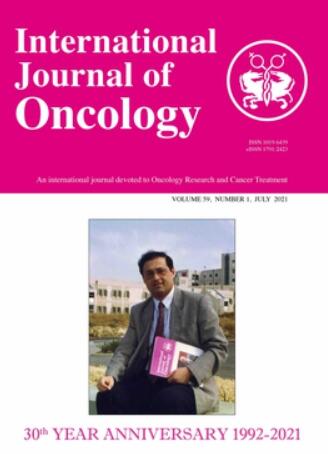RPL9 acts as an oncogene by shuttling miRNAs through exosomes in human hepatocellular carcinoma cells.
IF 4.5
3区 医学
Q1 ONCOLOGY
引用次数: 0
Abstract
The exosomal pathway is an essential mechanism that regulates the abnormal content of microRNAs (miRNAs) in hepatocellular carcinoma (HCC). The directional transport of miRNAs requires the assistance of RNA‑binding proteins (RBPs). The present study found that RBPs participate in the regulation of miRNA content through the exosomal pathway in HCC cells. First, differential protein expression profiles in the serum exosomes of patients with HCC and benign liver disease were detected using mass spectrometry. The results revealed that ribosomal protein L9 (RPL9) was highly expressed in serum exosomes of patients with HCC. In addition, the downregulation of RPL9 markedly suppressed the proliferation, migration and invasion of HCC cells and reduced the biological activity of HCC‑derived exosomes. In addition, using miRNA microarrays, the changes in exosomal miRNA profiles in HCC cells caused by RPL9 knockdown were examined. miR‑24‑3p and miR‑185‑5p were most differentially expressed, as verified by reverse transcription‑quantitative PCR. Additionally, using RNA immunoprecipitation, it was found that RPL9 was directly bound to the two miRNAs and immunofluorescence assays confirmed that RPL9 was able to carry miRNAs into recipient cells via exosomes. Overexpression of miR‑24‑3p in cells increased the accumulation of miR‑24‑3p in exosomes and simultaneously upregulated RPL9. Excessive expression of miR‑24‑3p in exosomes also increased their bioactivity. Exosome‑mediated miRNA regulation and transfer require the involvement of RBPs. RPL9 functions as an oncogene, can directly bind to specific miRNAs and can be co‑transported to receptor cells through exosomes, thereby exerting its biological functions. These findings provide a novel approach for modulating miRNA profiles in HCC.RPL9 通过外泌体在人肝癌细胞中穿梭 miRNA,从而成为一种致癌基因。
外泌体途径是调节肝细胞癌(HCC)中微RNA(miRNA)异常含量的重要机制。miRNA 的定向运输需要 RNA 结合蛋白(RBPs)的协助。本研究发现,RBPs 通过外泌体途径参与调控 HCC 细胞中 miRNA 的含量。首先,利用质谱技术检测了HCC患者和良性肝病患者血清外泌体中不同蛋白质的表达谱。结果显示,核糖体蛋白 L9(RPL9)在 HCC 患者血清外泌体中高表达。此外,下调 RPL9 能显著抑制 HCC 细胞的增殖、迁移和侵袭,并降低 HCC 外泌体的生物活性。通过反转录定量 PCR 验证,miR-24-3p 和 miR-185-5p 的表达差异最大。此外,利用 RNA 免疫沉淀法发现,RPL9 与这两个 miRNA 直接结合,免疫荧光试验证实 RPL9 能够通过外泌体将 miRNA 带入受体细胞。在细胞中过表达 miR-24-3p 会增加 miR-24-3p 在外泌体中的积累,同时上调 RPL9。miR-24-3p在外泌体中的过量表达也增加了它们的生物活性。外泌体介导的 miRNA 调控和转移需要 RBPs 的参与。RPL9 作为一种致癌基因,可直接与特定的 miRNA 结合,并可通过外泌体共同转运到受体细胞,从而发挥其生物学功能。这些发现为调节 HCC 中的 miRNA 配置提供了一种新方法。
本文章由计算机程序翻译,如有差异,请以英文原文为准。
求助全文
约1分钟内获得全文
求助全文
来源期刊
CiteScore
9.60
自引率
0.00%
发文量
157
审稿时长
2.1 months
期刊介绍:
The main aim of Spandidos Publications is to facilitate scientific communication in a clear, concise and objective manner, while striving to provide prompt publication of original works of high quality.
The journals largely concentrate on molecular and experimental medicine, oncology, clinical and experimental cancer treatment and biomedical research.
All journals published by Spandidos Publications Ltd. maintain the highest standards of quality, and the members of their Editorial Boards are world-renowned scientists.

 求助内容:
求助内容: 应助结果提醒方式:
应助结果提醒方式:


